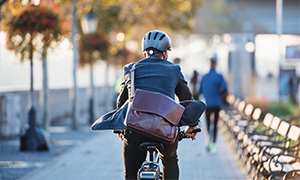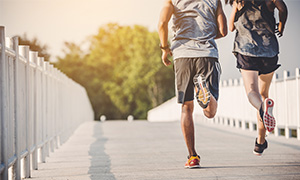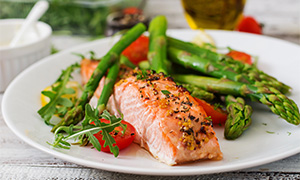
2025: The Year of the Bike!
Get Fit with Cycling this New Year
By Anna Jones at Eversure,
2 January 2025, 20 min read
Did you receive a bike for Christmas? Maybe you have one gathering dust that you're ready to take seriously? Or possibly, you are a seasoned cyclist determined to make 2025 your best cycling year yet! The beginning of a new year brings a sense of optimism and an opportunity for a fresh start. Many of us adopt the ‘new year, new me’ mindset and make ambitious health and fitness goals for the year, but sticking to them can be difficult. People often set overly ambitious goals that lead to burnout and frustration causing many to give up.
However, if you are determined to kickstart or reignite your passion for cycling and are committed to your cycling resolution this new year, then you are in the right place! This guide is full of tips and strategies to help you make 2025 your best year for cycling yet.
Set Clear Goals

Before hopping onto your bike saddle, take a moment to consider your main cycling goals for the year. Do you want to increase your speed, cover longer distances, or simply commit to starting and sticking with it? Whatever your aim, it’s essential to begin with short-term, achievable goals. For beginners, this might mean cycling 20-30 minutes a week, while more experienced riders may set a target of reaching a specific number of kilometres weekly.
If you have larger goals in mind, like cycling 100 kilometres, break them down into manageable steps to make steady progress. For example, if you're currently cycling 0 km per week, start with 15 km. Once that feels comfortable, gradually increase the distance each ride, and you'll reach your 100 km target in no time.
Alternatively, you could set time-based goals. In your first week, aim to ride for 20 minutes. Once that becomes easier, add 10 minutes to each session. Before you know it, you'll be riding for hours and comfortably covering longer distances. Breaking a big goal smaller milestones will keep you motivated as you will be hitting targets along the way whilst still contributing to overarching goal without the process feeling daunting or overwhelming.
Slow and Steady
If you are new to cycling or if you are returning after some time off, it is important to start slowly. Even for intermediate and advanced cyclists, going slowly is crucial. This approach is known as ‘base training’ and focuses on long, steady rides at a lower heart rate (zones 1 and 2). Don’t worry if you don’t have a heart rate monitor, just focus on maintain a pace that feels comfortable and that you can easily hold a conversation at. Training like this will strengthen your aerobic system and make you much more efficient. When your rides are not too challenging or demanding you are also more likely to be motivated and stay consistent.
For beginners, this slow and steady approach is key. Pushing yourself too hard too soon will only lead to exhaustion, injury and frustration. You will be less likely to enjoy the process of reaching your goal and will be more likely to give up. In fact, riding above your endurance pace offers minimal benefits and leads to quicker fatigue and reduced enjoyment which is just as important.
So, take the time to build your endurance. Cycling is a long-term journey and starting slowly will build a foundation you need to improve over time. Slow down and enjoy the scenery!
Interval & Threshold Training
If you are aiming to conquer demanding ascents that you may encounter abroad in European cycle races or tours, then you will eventually need to start working on raining your functional threshold power (FTP) with interval and threshold training. Once you have established a solid fitness base, consider incorporating interval and threshold training to increase your speed on the bike. If you are a more experienced cyclist and haven’t tried this style of training yet, then definitely consider adding a session into your routine.
Interval training involves short bursts of all-out effort followed by recovery periods which can improve both your endurance and your speed. A simple interval workout could consist of 30 seconds of maximum effort sprints followed by 90 seconds of easy spinning. Repeat this 8-10 times and you would have completed a rewarding interval session guaranteed to get those endorphins flowing!
Threshold training is another effective mode of training where you ride just below or at your lactate threshold. This is the point just before your body starts producing lactic acid, which makes your muscles fatigue thus you feel sluggish. This threshold is typically 80% of your maximum effort. Training at or near this level will help you sustain a higher pace over longer durations.
An additional cycling workout you could do would be to try intervals of 20 seconds, working just above your threshold, followed by 40 seconds of easier cycling. This is a powerful combination that will speed you up and enhance your performance!
If as a beginner this sounds daunting to you then don’t worry! Just focus on getting those crucial minutes and kilometres under your belt first before worrying about your speed.
Here is an example of a month-long cycling plan that includes endurance rides, recovery rides (which you should take at an even slower, easier pace), intervals and hill sessions. It also includes cross training and rest days to allow balance and recovery.
|
Monday |
Tuesday |
Wednesday |
Thursday |
Friday |
Saturday |
Sunday |
| Week 1 |
Endurance ride (60-75 mins) |
Strength training |
Rest day |
Intervals (8 x 30 sec sprints, 90 secs easy) |
Strength training |
Cross training (yoga, running, swimming etc ) |
Recovery ride (30-45 mins) |
| Week 2 |
Hill ride (60-75 mins endurance with 4-6 hill repeats) |
Strength training |
Cross training (yoga, running, swimming etc) |
Endurance ride (75-90 mins) |
Strength training |
Rest day |
Threshold ride (60 mins just below lactate threshold) |
| Week 3 |
Intervals (6 x 2 mins high intensity, 2 mins easy) |
Strength training |
Recovery ride (30-45 mins) |
Cross training (yoga, running, swimming etc) |
Strength training |
Endurance ride (90 -120 mins) |
Rest day |
| Week 4 |
Threshold ride (60 mins just below lactate threshold) |
Strength training |
Intervals (5 x 3 mins high intensity, 3 mins easy) |
Rest day |
Strength training |
Endurance ride (90 -120 mins) |
Cross training (yoga, running, swimming etc) |
This is just guidance so feel free to adapt it based on your schedule and commitments!
Cycling as a Mode of Transport

Add cycling into your daily life and use it as a replacement for the short journeys you make by car. Incorporating cycling into your daily routine—whether it's commuting to work (or to the station), cycling to the store, or going to the gym—can effortlessly boost your mileage and even serve as a recovery spin between more intense and dedicated sessions. Cycling instead of driving also saves money on parking.
Why not squeeze in a quick bike ride during your lunch break? It’s a great way to step away from the screen, clear your mind, and break up the workday.
If you're balancing training with a full-time job, adopting a ‘little and often’ approach will help you stay consistent. Using the bike functionally to make a journey you already do is a great way to build that momentum.
Accountability
Staying accountable manifests many different ways. Perhaps you need cycling friend – someone you can’t cancel on and who won’t cancel on you. Consider joining a cycling group for extra motivation. You could also book an event in like a race, a charity cycle or a cycling tour abroad. You can also join challenges on apps like Strava and compete with friends or with yourself, seeing if you can beat your previous times. Strava is also an excellent tool for tracking your progress and staying motivated over time.
Track Your Progress
In the same vein, consider using a fitness app or a cycling computer to track your rides. Reviewing your ride history can be incredibly satisfying and enables you to compete with your past self, as well as reflecting on how much you’ve improved. These tools measure important metrics such as the distance you've covered, your speed, and the elevation gained, providing valuable insights into your progress over time.
Accompanying Exercise

As well as mixing up your cycling workouts, it’s important to diversify your overall fitness routine. Complement your cycling with strength training, yoga, running, tennis, team sports or any other activity you enjoy. This will help prevent muscle imbalances, get in some active recovery, and boost your overall strength, flexibility and endurance. Trying new things will also make your fitness routine more interesting!
When it comes to strength training, prioritise functional exercise that targets key muscles group used in cycling such as your core, glutes, quads, hamstrings and your lower back. Essential exercises include squats, deadlifts, lunges and kettlebell swings. For core stability, incorporate movements like planks, Russian twists and leg raises. Adding gentler work outs into your training like yoga or Pilates is also beneficial to your performance as it can increase your flexibility, improve your breathing techniques and aid your recovery. Aside from cycling, these practices also help you achieve mental stillness which will help you manage stress.
To mix up your cycling routine, consider swapping out a bike ride for cross-training activities like swimming or running. These alternatives engage different muscles groups to cycling so you will continue to improve your overall fitness whilst reducing the chance of injury associated with overuse of muscle groups.
Recovery
Remember that non-active recovery is just as integral as all your workouts. Giving your body a proper break allows you some well-earned down time to rest and recharge. Resting not only aids your recovery but also boosts your motivation to get back out there as you can tackle your next bike ride with even more energy and enthusiasm!
After each ride make sure to take the time to stretch as this will reduce your muscle soreness and tension. Add a foam roller into your routine to further enhance your recovery by stimulating blood flow to your legs. For those of you that are more serious cyclists, why not look to invest in a massage gun if you haven't already.
Quality Sleep
Foam rolling, massage guns and stretching are all excellent for recovery, but quality sleep supersedes these. Good sleep is essential for giving your muscles time to repair, reduce your levels of fatigue and improving your overall performance. Sleep is also crucial for endurance athletes as it helps your body store the all-important glycogen that fuels long rides which are categorised by lasting 90 minutes or more. As glycogen levels reduce without sufficient rest, you will have less energy for your long bike rides. In fact, cyclists who focused on optimising their sleep are said to have improved their performance by a staggering 15%!
When you are sleep deprived, the part of your brain that controls emotion, the amygdala becomes 60% more active leading to increased stress and mood swings. Focus on getting 7 to 9 hours of quality sleep each night and your mental sharpness, mood stability and motivation will all improve as well as your cycling performance. This will be hugely motivating and so will help you stay consistent with your training, making sure you achieve the goals you set at the start of the year.
Nutrition and Fuel

Good nutrition is essential for performance and recovery as cycling is an energy-intensive sport. If you want to enjoy long bike rides then you must be well-fuelled; going out for a ride on an empty stomach will simply limit your speed and reduce how far you feel you’re able to go. Not only will your muscles fatigue faster but the overall ride will be far less enjoyable.
When it comes to optimising cycling nutrition you should focus on your carb and protein intake, which supports muscle growth. Of course you need to be including fruits, vegetables and healthy fats into your diet for a generally healthy and balance diet.
For longer rides that are over an hour, aim to eat a meal with carbs, protein and healthy fats 2 to 3 hours beforehand to allow it to digest. Porridge made with protein powder and topped with your favourite nut better and some fresh fruit is a fantastic option.
If you plan to be cycling for over 90 minutes, then consider taking some fuel on the bike with you. The aim is to have 30-69 grams of carbs per hour but don’t worry too much about that if you are only a beginner! For shorter rides, water may be enough to see you through, but it wouldn’t hurt to bring some snacks to maintain your energy levels. Energy gels, fruit like bananas or dates and protein bars are all excellent choices. Dehydration can reduce your performance so make sure to bring some water or sports drinks along with you too.
To refuel after the ride, try to have a 3:1 carb to protein meal within 30-60 minutes of completing your cycle. This will allow you to replenish those all-important glycogen stores and will fuel your muscles to assist in their recovery. A tuna sandwich is a great for this, or some eggs with toast – one of the best cycling perks is that you get to enjoy two breakfasts!
If you are struggling for healthy, nutritionally balanced meal and snack ideas then look at our list that details of three breakfast, lunch and dinner ideas:
Breakfast
- Yoghurt topped with fruit, granola, nuts and seeds
- Add some protein powder into this to really bump up your protein intake.
- Banana pancakes
- Eggs
- Cook them any way! We suggest an omelette so you can also get some protein and vegetables in.
Lunch
- Wrap with a protein source of your choice
- Add in some spinach, avocado and hummus for even more protein.
- Pasta salad
- Soup with bread
Dinner
- Risotto with a protein source of your choice
- Chicken and bean fajitas
- Salmon rice bowl
Enjoy it!
Focusing on your enjoyment whilst cycling is so important. It will increase your motivation to get out there and achieve all those New Year’s resolutions. Listen to music, a podcast or an audiobook but make sure you are still aware of your surroundings – getting some bone conduction headphones is a great way to do this. Alternatively, you could mix up your routes. Cycling is a fantastic way to discover new places, so choose a scenic countryside route and take in all the views.
What are the Benefits of Cycling?
Perhaps you need a little more motivation to get out there and smash your resolutions. If you do need a boost, then read these physical and mental health benefits that come with consistent cycling:
- Heart health: Cycling is a great way to improve your cardiovascular health as it improves your circulation and reduces your risk of heart disease.
- Joint friendly: Unlike running or other high-intensity exercises, cycling is gentle on your joints. This means it is suitable for all ages and fitness levels. As it is not weight bearing, injury rates are also lower.
- Mental well-being: Exercise boosts your serotonin levels and enhances your mood, and cycling is no different. After completing a ride, you’ll experience a rush of endorphins and a sense of accomplishment, particularly if it was challenging. Time outdoors, away from a screen and breathing in fresh air also does wonders for clearing your mind.
- Grows your social circle: Cycling is a highly social sport. Join a local club to connect with fellow bike enthusiasts, many communities will have some that meet on weekends. Being part of a club will offer a sense of camaraderie and is also the place to be if you need bike maintenance tips or training advice.
- Environmentally friendly: Choosing to cycle for your commute or to run errands in place of where you would use the car, you will be reducing your carbon footprint significantly. Of course, this is increasingly importance.
Look back at this list when you are dreading getting on the bike!
Final Thoughts
Ultimately, the key is to make small sustainable changes that can be built around your existing routines and your lifestyle. Gradually build on these habits and increase them so that you don’t notice all the change at once. If you follow our tips, you will be able to look back at the end of the year, see how far you’ve come and reflect on the progress you’ve made.
Please be mindful that if you are cycling in the early months of the new year such as January and February, you will want to make sure bike is equipped for the harsh winter conditions, read our guide on winter bike prep for more information on how to do this.